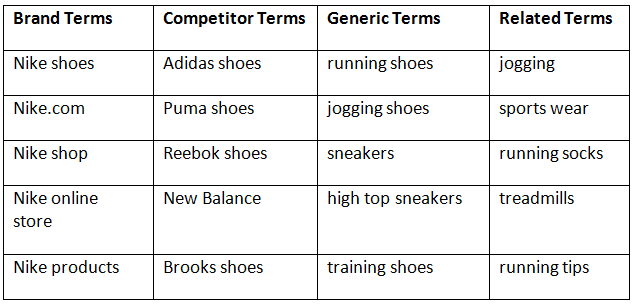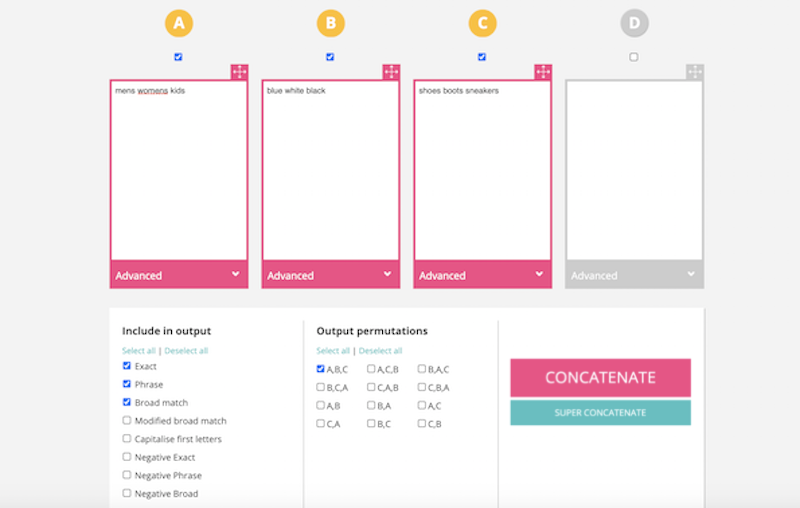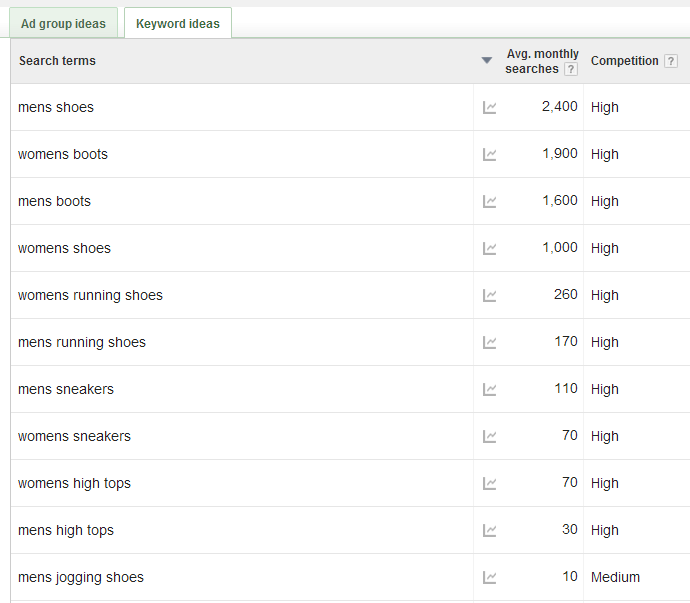Deciding which keywords make it into your paid ad campaign is one of the most important decisions you’ll make when it comes time to creating your own. Choosing keywords that you believe will generate the most clicks and conversions is really important but this process is both a science and art and that makes it more difficult than you think. Sometimes you’re right and sometimes you’re wrong…but that’s ok. :)
To help make your life a little easier there are a myriad of tools at your disposal but really, understanding your customers and predicting which terms they’re actually typing into the search box is born from knowing who they are, what they do and why they do it. It’s knowledge that typically only exists in either knowledgeable business owners or smart marketing agency staff. cough
In this short guide, we’ll show you a methodology to help you acquire, refine and organise your Google Ad keywords resulting in a better targeted ad campaign with a higher Return On Investment.
Where to start: Brainstorm a starter PPC Keyword List
An easy way to to kick things off is to review the Landing page that your new campaign will point to. Scanning each page and harvesting relevant keywords from the text will get your list started with words appropriate to target. Assuming you have a website that was written by a smart/knowledgeable person there should be plenty of material to put together a fairly comprehensive list of keywords that directly relate to your products or services.
Keywords used in Google Ad campaigns can be broadly broken down into the following types:
- Brand terms - any keywords containing your brand name and trademarked terms.
- Generic terms - terms relating to products or services offered.
- Related terms - terms that don’t directly relate to what you’re selling but that users who want your products services may be searching for.
- Competitor terms - the brand names of competitors who are offering similar products and services to yours.
Let’s say you were researching a Google Ad campaign to advertise Nike running shoes - the keywords structure might look a little like this >

Bidding types are an important element of keyword lists
Whilst bidding on competitor brand terms is sometimes the right thing to do - usually it’s not. They are usually more expensive than other brand-less keywords and can quickly eat through your budget - especially modest budgets used by small businesses like yours. When thinking about bids, you really want to approach it from an ROI perspective - if it doesn’t return more than it costs - scrap it. There is plenty more opportunity out there to use.
Still thinking about creating that list of keywords?
Empathise with your customer.
What kinds of words and queries would they need to type (or speak) into the search box to bring them to your website?
Start with Broad keywords and then move into more specific types
For example Shirts > Women’s shirts > women’s long-sleeve shirts -> Women’s black long-sleeve shirts.
Include variations and synonyms in your keyword list
Google Search can sometimes make connections between related terms like “tyres” and “wheels” but not always. It’s best to include them - especially if you’re planning to set your match type to Exact. The same goes for short forms, abbreviations and also plurals.
To use the example above, I’d probably include variations like ;
- Women’s long-sleeve shirts
- Women’s long-sleeve tees
- Women’s long-sleeve Ts
- Women’s long-sleeve t-shirts
- Etc etc
consider specificity when selecting your keywords
I can be valuable to include broad terms in a campaign - usually single words or short phrases because they have a higher search volume however, a broad keyword like “shirts” could be used by people searching for women’s shirts, kid’s shirts, men’s shirts and so on - your product won’t always be relevant to them. On the other hand, a very specific long tail-keyword phrase like “men’s black long-sleeve shirts” might only get searches per month but the user will be much more likely to click your ad and follow through with a purchase because it’s exactly what the person is looking for. As an added bonus, long-tail keywords are less competitive and therefore less costly.
Include keywords that are related to your products or services is key
Attracting customers that will likely be interested in what you’re selling is usually attributed to using keywords that are directly related to your products/services. For example, if you sell dog food you could include topics that dog owners search for, such as dog grooming, dog breeds, dog health issues, dog sitters, dog accessories and so on.
Concatenation might be your BFF
Found.com provides a fantastic service for this. Expanding a keyword list by merging columns of words together using online tools like this will save lots of time. In the example below, you’ll see that the third column contains the product and the two others include modifiers. The tool generates a list of all possible permutations of those nine terms.

Concatenation tools can save time and build better performing lists
Typos happen to everyone but especially in searches
Including typos in your keyword list is useful although Google has become a lot better at capturing these and correcting them before performing a search - but it still lets some through which is why this made it onto our list. A word of advice here - if you’re using DKI (Dynamic Keyword Insertion) you’ll want to skip this stage otherwise your ad will include the typo. Not good but great for Responsive or Text ad types.
Google search is increasingly able to understand longer strings of words
There are a number of voice led searches occurring now from people just speaking into their device (think Alexa and Siri). You might want to take this into account and include not only search terms that might come from a keyboard but terms that reflect how people actually speak - they aren’t one in the same. An example might be - “Cafe near me” but someone searching on the phone might say “find a nice cafe in Cambridge” or “where can I get a nice coffee close by?”. Don’t be afraid to include variations such as “How can I” or “How do you”.
There is no shame in using modern tools to expand and refine your Keyword list
When you’ve compiled a neat list of keywords that you believe will churn butter into cream, the next step is to us a keyword research tool to determine which keywords should be kept and which should be dropped. It’s not enough to just go on your gut - keyword tools help you zero in on the terms that people are actually typing into search engines. There are dozens of tools to give you insights into how popular certain keywords are, from Google keyword planner (which is free inside of Google Ads - it’s also tremendously valuable) and Wordstream’s free keyword suggestion tools.
Each keyword tool is a little different but the key stat you’re looking for is search volume. The higher the search volume, the more people are searching for that given term per month.

Google Ads own Keyword tools are extremely powerful & FREE
With the Google Ads Keyword Planner, you can also discover a Competition rank. A high competition rating means that more advertisers are bidding on these terms which means you’ll have to pay more to get your ad to top positions.
In the example above, the search term “men’s jogging shows” at the bottom of the list has low search volume - just an average of 10 searches per month. However, on the plus side the competition index is low.
We’re looking for High volume searches with low competition rank. That’s the sweet spot where we stand the highest chances of capturing clicks and increasing our conversion rate.
Some keyword tools like the Keyword Planner can also suggest additional keyword ideas that you may have missed in your initial list. Free online tools like Ubersuggest and Soovle can help with this too - but can be too simple for complex requirements.
Keywords with very little search volume or where competition is high are likely to eat through your budget extremely quickly whilst offering nothing much in return. Using the keyword tools you will be able to prune back certain keywords and also discover new keywords.
Google Ads works better when keyword lists are organised
If you’ve made it this far down our checklist, you should have a pretty comprehensive list of keywords for your Google Ads campaign. Bravo! It’s now time to sort your new keyword list into small, targeted groups of keywords that are closely related to each other in preparations for putting them into Ad Groups within Google Ads.
If you’re selling a simple/straight-forward list of products or services a good rule of thumb is for your ad groups to mimic the structure to your website. For example, if you’re selling dog food your campaign might look something like this.
- Brand - Purina Dog Food
- Brand - IAMS Dog Food
- Brand - Royal Canin Dog Food
- Generic - Dog Food
- Generic - Dog Food - Chicken
- Generic - Dog Food - Beef
- Generic - Dog Food - Kibble
- Generic - Puppy Food
The more focused your ad groups are - the easier it will be to
- Measure the performance
- Prune or expand your lists if necessary
- Create highly specific and relevant ads
The last point is crucial. Small and tight ad groups have a multiplying beneficial effect on your account. Well organised campaigns have more relevant and higher relevant leads to higher Quality Scores which as we’ve told you many times simultaneously increase your ad rankings and reduce what you pay for each click and thus each conversion. Health PPC accounts have better Quality Scores, lower Click costs and higher conversion rates.
Never forgot Negative Keywords.
ABAN - Always Be Adding Negatives
As you do forth and create your keyword lists don’t forget about negative keywords. These are the search terms that you don’t want your ads to show up for and they’re an important part of any campaign because they help control costs and keep your ad targeting as relevant as possible.
The main reason to include negative keywords it to present your ads - and by extension your brand from showing up alongside search queries that are irrelevant or offensive .For example a seller of high-end furniture would want to target affluent customers and would add terms like cheap and free to the negatives list to prevent their ads for appearing alongside those terms. You’ll also want to rule out impressions on terms that are similar to but not really related to your business - such as “Hair Dryer” if you sell home appliances/white goods including washers and dryers.
A few tips for uncovering negative keywords for your Google Ad campaign
Keep and eye on your search query reports.
This is a great way to find out what real searchers are looking for when Google serves your ad. If you see words in your search query report that you know are not a good fit for your account, set them as negatives before you run the risk of showing for them again.
Understand negative match types
The match type that you assign to the negative keyword has an enormous influence over the results. As a general rule of thumb, use Broad match negatives to disqualify any query that contains your negative term such as ‘free’. Use phrase and exact match negatives to disqualify more specific queries that contain long-tail negative keywords. Be careful because Phrase and Exact matches are becoming closer entwined so by using Exact, it can be more similar to Phrase than you thought and negate more searches than you want.
Explore negative keyword options before your campaign goes live.
If there are keywords that you know will be used before your campaign goes live that will be used by people you don’t want to attract or keywords that represent products or services you do not offer, add them to the negative keyword list. Not doing so, will likely use your budget to capture the attention of the wrong type of customer.
Multi-level negatives are a thing and should be used.
Changes are you will identify some negative that are a good fit across multiple ad groups or campaigns. You can assign negative lists to specific groups or campaigns or accounts - different lists for different intentions or product types might be a clever way of building your lists.
Don’t go too far.
Negatives are a great way to minimize errant spend. Improperly used negative keywords can hurt your account and kill your impression volume. As you set each negative keyword make sure that you’re confident the keyword is not going to convert your customers. Just a single keyword mistakenly included in a negative keyword list can zap all conversions from the account overnight.


